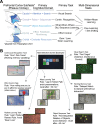This is a preprint.
A Multi-task Platform for Profiling Cognitive and Motivational Constructs in Humans and Nonhuman Primates
- PMID: 38014107
- PMCID: PMC10680597
- DOI: 10.1101/2023.11.09.566422
A Multi-task Platform for Profiling Cognitive and Motivational Constructs in Humans and Nonhuman Primates
Abstract
Background: Understanding the neurobiological substrates of psychiatric disorders requires comprehensive evaluations of cognitive and motivational functions in preclinical research settings. The translational validity of such evaluations will be supported by (1) tasks with high construct validity that are engaging and easy to teach to human and nonhuman participants, (2) software that enables efficient switching between multiple tasks in single sessions, (3) software that supports tasks across a broad range of physical experimental setups, and (4) by platform architectures that are easily extendable and customizable to encourage future optimization and development.
New method: We describe the Multi-task Universal Suite for Experiments (M-USE), a software platform designed to meet these requirements. It leverages the Unity video game engine and C# programming language to (1) support immersive and engaging tasks for humans and nonhuman primates, (2) allow experimenters or participants to switch between multiple tasks within-session, (3) generate builds that function across computers, tablets, and websites, and (4) is freely available online with documentation and tutorials for users and developers. M-USE includes a task library with seven pre-existing tasks assessing cognitive and motivational constructs of perception, attention, working memory, cognitive flexibility, motivational and affective self-control, relational long-term memory, and visuo-spatial problem solving.
Results: M-USE was used to test NHPs on up to six tasks per session, all available as part of the Task Library, and to extract performance metrics for all major cognitive and motivational constructs spanning the Research Domain Criteria (RDoC) of the National Institutes of Mental Health.
Comparison with existing methods: Other experiment design and control systems exist, but do not provide the full range of features available in M-USE, including a pre-existing task library for cross-species assessments; the ability to switch seamlessly between tasks in individual sessions; cross-platform build capabilities; license-free availability; and its leveraging of video-engine capabilities used to gamify tasks.
Conclusions: The new multi-task platform facilitates cross-species translational research for understanding the neurobiological substrates of higher cognitive and motivational functions.
Keywords: Diagnostic Battery; naturalistic behavior; nonhuman primates; video-engine; virtual reality.
Conflict of interest statement
Financial Disclosures The authors declare no competing financial interests.
Figures







Similar articles
-
USE: An integrative suite for temporally-precise psychophysical experiments in virtual environments for human, nonhuman, and artificially intelligent agents.J Neurosci Methods. 2019 Oct 1;326:108374. doi: 10.1016/j.jneumeth.2019.108374. Epub 2019 Jul 25. J Neurosci Methods. 2019. PMID: 31351974
-
A Kiosk Station for the Assessment of Multiple Cognitive Domains and Cognitive Enrichment of Monkeys.Front Behav Neurosci. 2021 Aug 26;15:721069. doi: 10.3389/fnbeh.2021.721069. eCollection 2021. Front Behav Neurosci. 2021. PMID: 34512289 Free PMC article.
-
CalliCog: an open-source cognitive neuroscience toolkit for freely behaving nonhuman primates.bioRxiv [Preprint]. 2024 Nov 26:2024.11.26.625450. doi: 10.1101/2024.11.26.625450. bioRxiv. 2024. Update in: Cell Rep Methods. 2025 May 19;5(5):101034. doi: 10.1016/j.crmeth.2025.101034. PMID: 39651268 Free PMC article. Updated. Preprint.
-
Cognitive deficits in bipolar disorders: Implications for emotion.Clin Psychol Rev. 2018 Feb;59:126-136. doi: 10.1016/j.cpr.2017.11.006. Epub 2017 Nov 21. Clin Psychol Rev. 2018. PMID: 29195773 Free PMC article. Review.
-
The NEWMEDS rodent touchscreen test battery for cognition relevant to schizophrenia.Psychopharmacology (Berl). 2015 Nov;232(21-22):3853-72. doi: 10.1007/s00213-015-4007-x. Epub 2015 Jul 24. Psychopharmacology (Berl). 2015. PMID: 26202612 Review.
Cited by
-
Non-human primates can flexibly learn serial sequences and reorder context-dependent object sequences.PLoS Biol. 2025 Jun 23;23(6):e3003255. doi: 10.1371/journal.pbio.3003255. eCollection 2025 Jun. PLoS Biol. 2025. PMID: 40549822 Free PMC article.
References
-
- Aragona M. (2014). Epistemological reflections about the crisis of the DSM-5 and the revolutionary potential of the RDoC project. Dialogues in Philosophy, Mental and Neuro Sciences, 7(1), 11–20.
-
- Axelsson S. F. A., Horst N. K., Horiguchi N., Roberts C., A., & Robbins T. W. (2021). Flexible versus Fixed Spatial Self-Ordered Response Sequencing: Effects of Inactivation and Neurochemical Modulation of Ventrolateral Prefrontal Cortex. Journal of Neuroscience, 41(34), 7246–7258. 10.1523/JNEUROSCI.0227-21.2021 - DOI - PMC - PubMed
Publication types
Grants and funding
LinkOut - more resources
Full Text Sources
